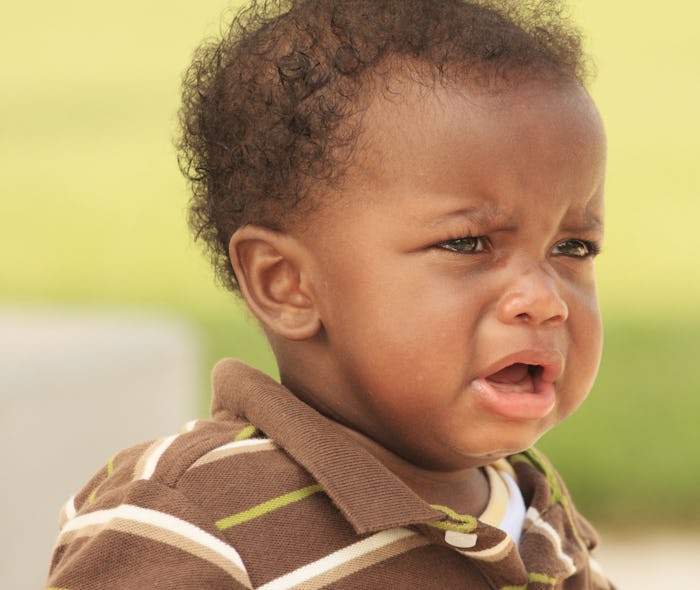Life

What To Do If Your Baby Is Stung By A Bee, According To Experts
As the weather gets warmer, it's so freeing to be able to get outside, especially if you've been hibernating with a new baby all winter. Most of the time those outings will be completely uneventful, but being out in nature has its risks and, well, one of them is bee stings. Even if you're extremely vigilant, it can happen, so you need to know what to do if your baby is stung by a bee.
The first thing to do? Don't panic. There are really specific things that need to happen and your baby will not be helped by a parent who is freaking out. Next up? You need to get the stinger out. A bee generally leaves their stinger in the victim's skin and the stinger contains a tiny sac of venom, according to What to Expect. That venom has proteins which can, and probably will, cause pain and swelling. The longer the stinger is in the baby's skin, the more venom they will receive, so the priority is stinger removal. This isn't as easy as just pulling it out, so if the stinger is still on your baby's body it needs to be approached with care. You'll know the stinger is there because you'll see a black dot, possibly surrounded by redness and swelling. She Knows Pregnancy and Baby said that some medical professionals suggest you use a flat object, like a credit card, to remove the stinger by scraping it. You don't want to grab a tweezers to do it, because you'll wind up squeezing the venom out as you grip the stinger with the tweezers. Of course, all of this is extra challenging in a crying, writhing baby. It may be a two-man job, so if someone is with you, have them hold the baby while you scrape or vice versa.
After you've gotten the stinger out, you want to treat the area and help reduce the pain and swelling. Baby Motrin or Tylenol can be useful, but they take a little while to kick in. Wash the area carefully with soap and water. If your baby will tolerate it, try to hold an ice pack on the sting site for about 15 minutes, as She Knows Pregnancy and Baby suggests. And, according to BabyCenter, you could even use frozen veggies or few ice cubes in a bag. If you don't have access to any of the aforementioned, try a cold water soaked paper towel or washcloth. BabyCenter also recommends a baking soda and water paste to soak out some of the venom and soothe the skin. If your baby starts scratching, What to Expect suggests you give an antihistamine, like Benadryl, to reduce itching. The worry is that the scratching could lead to an open wound, which could lead to infection.
This is all good protocol if your baby is not allergic to bee stings, but what if they are? You won't really know it until that first sting, unfortunately. If you notice wheezing or trouble breathing, swollen mouth or lips, hives, vomiting, or loss of consciousness, What To Expect says to call 911 or go to an emergency room immediately. Allergic reactions are more acute the second time, so if your child has had a previous reaction, you should carry an epinephrine pen with you. This will treat the baby immediately. Talk to your doctor about this because you will need a prescription for it.
Short of keeping your baby in a bubble, it's hard to prevent these types of things. You can try to avoid places where there are a lot of bees, make sure your baby doesn't have spilled juice or something sweet on their skin or clothing, and don't swat at the bees if they are nearby, as it'll only make them more prone to sting. Be wary, but also feel good now that you know what to do in case it happens.
Check out Romper's new video series, Bearing The Motherload, where disagreeing parents from different sides of an issue sit down with a mediator and talk about how to support (and not judge) each other’s parenting perspectives. New episodes air Mondays on Facebook.